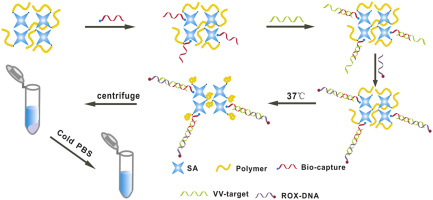Talanta ( IF 5.6 ) Pub Date : 2017-12-22 , DOI: 10.1016/j.talanta.2017.12.068 Xinxin Wang , Mingyuan Du , Guobin Mao , Jiao Zheng , Jinyang Chen , Xinghu Ji , Zhike He

|
A new kind of polymeric material (PNIPAAm-co-SA) was prepared by conjugating a thermosensitive polymer, Poly (N-isopropylacrylamide) (PNIPAAm) with streptavidin (SA). This smart prepared composite displayed a controllable conformation change between an expanded and a collapsed form, below or above its lower critical solution temperature (LCST). Differential scanning calorimetry (DSC) analysis demonstrated that the PNIPAAm-co-SA bioconjugate showed the same LCST as the original synthetic polymer, PNIPAAm, which was also 32 °C. Based on the specific interaction between SA and biotin, a higher capture efficiency of PNIPAAm-co-SA, which was almost 100% in PBS buffer solution and above 70% in serum was obtained, respectively. And the high affinity between PNIPAAm-co-SA and biotin was still maintained after three heating cycles. Subsequently, the variola virus (small pox, VV) oligonucleotide sequence was chosen as a model to demonstrate the sensitivity of the biosensor which was fabricated based on PNIPAAm-co-SA. The biosensor exhibited the ability to separate and enrich targets from complicated system with its phase transition ability, and high sensitivity toward VV-targets were achieved. Moreover, other types of targets such as proteins and cells, could be detected by changing the biotin-captures, which indicated the broad applicability of biosensors based on this smart polymer material.
中文翻译:

智能链霉亲和素功能化聚(N-异丙基丙烯酰胺)复合物的合成及其在病毒核酸分离与检测中的应用
通过将热敏聚合物聚(N-异丙基丙烯酰胺)(PNIPAAm)与链霉亲和素(SA)偶联制备了一种新型的聚合物材料(PNIPAAm-co-SA)。在低于或高于其较低的临界溶液温度(LCST)的情况下,这种智能制备的复合材料在膨胀形式和塌陷形式之间显示出可控的构象变化。差示扫描量热法(DSC)分析表明,PNIPAAm-co-SA生物共轭物显示的LCST与原始合成聚合物PNIPAAm相同,也是32°C。基于SA和生物素之间的特异性相互作用,分别获得了较高的PNIPAAm-co-SA捕获效率,在PBS缓冲溶液中接近100%,在血清中超过70%。在三个加热周期后,PNIPAAm-co-SA与生物素之间仍保持高亲和力。随后,选择天花病毒(天花,VV)寡核苷酸序列作为模型,以证明基于PNIPAAm-co-SA的生物传感器的敏感性。该生物传感器具有相变能力,能够从复杂系统中分离和富集靶标,并且对VV靶标具有很高的灵敏度。此外,可以通过更改生物素捕获来检测其他类型的靶标,例如蛋白质和细胞,这表明基于这种智能聚合物材料的生物传感器具有广泛的适用性。并实现了对VV目标的高灵敏度。此外,可以通过更改生物素捕获来检测其他类型的靶标,例如蛋白质和细胞,这表明基于这种智能聚合物材料的生物传感器具有广泛的适用性。并实现了对VV目标的高灵敏度。此外,可以通过更改生物素捕获来检测其他类型的靶标,例如蛋白质和细胞,这表明基于这种智能聚合物材料的生物传感器具有广泛的适用性。











































 京公网安备 11010802027423号
京公网安备 11010802027423号